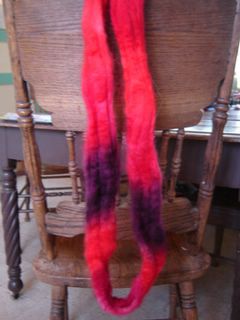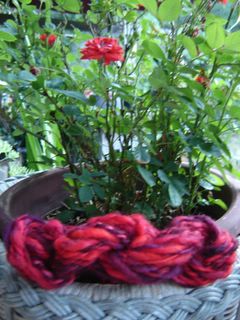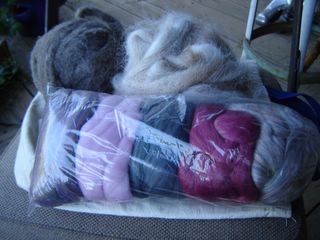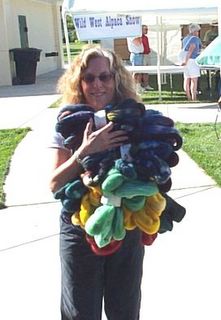Spinning Success Story
I have mentioned a bit that I bought a lovely Greensleeves spindle at Estes Park and have been trying to learn to spin since then... however, it wasn't until last Thursday on my early morning walk that it crossed my mind that my lack of success was possibly due to being left-handed. I recalled that the woman who sold me the spindle had said "just reverse the motions" so I unwound all the yarn and leader and rewound the opposite direction... not what I needed, I still couldn't get the right amount of twist to hold my yarn together. I planned to purchase a heavier practice spindle and a variety of fibers and see if one of my fellow guild members could help me out.
Then, I met Lisa at Lambtown. She had a display of $5.00 oak spindles, not fancy but very functional in her hands, as well as some very lovely choices in hand-dyed rovings. I picked up a spindle to buy, and then noticed that she was holding her wool in her right hand and pushing the spindle with the left, opposite of what most people do, but exactly what I had been trying to master!

Lisa, my spinning angel who corrected my errors and got me producing a real yarn. This is a really terrible photograph, but lying on the table are several of her beautiful rovings.
Lisa then showed me and helped me with the spindle, in a two-person version of "park and draft" until I was producing several yards of real, actual yarn that held together. Lisa caught on to what mistakes I had been making and I went around gathering up some wonderful other fibers to try out. I also met Connie Delaney, from Salmon, Idaho, and bought her book, Spindle Spinning: From Novice to Expert. Connie has also spent a lot of time coming up with a calculation system that allows you to figure out what to do with your handspun; check out her patterns, which do the math for you based on the wraps per inch you get with your handspun yarn. Plus, she was the judge for the spinning contests I wrote about yesterday and has a wicked sense of humor.
I headed home with my booty and started spinning. I began with this beautiful hand-painted Blue-faced Leicester roving, aptly named "Sangria", in love with the colors.

By Sunday, I had my spindle about 2/3rds full, and decided to take it off and try my hand at plying. I followed the instructions in Connie's very handy little book, and turned out a respectable but tiny skein of yarn, washed it and hung it to dry overnight.
Proud parent .... my first skein!

Here are some of the tidbits I got from my private lesson with Lisa:
1. She showed me how to use the hook on the top of the high whorl to put a spin on the first chunk of fleece and turn it into a leader; take it off the hook, tie or wrap around your spindle shaft and you are good to go.
2. A left-handed (legged, too) person like me needs to roll the spindle down the left leg to spin, producing a clockwise spin, and up to ply, producing a counter-clockwise spin.
3. Make sure the yarn comes up directly behind the hook in a straight line to keep the spindle spinning in balance.
4. Keep tension on your thread while winding on to the spindle.
5. When you quit a spinning session, allow the yarn near the hook to double back on itself (it will look plied) to hold your tension while stored; you can wrap this bit around the hook a time or two for insurance.
6. She encouraged me to "park and draft", meaning stopping the spindle between my legs and drafting the rest of the twist up the fibers, rather than get flustered, allow the spindle to reverse its spin, etc.
7. Stop and breathe periodically!
8. Fan out and draw out the roving before beginning to draft to allow the fibers room to "stretch".
9. If the twist runs too far up into the fibers, stop the spindle, untwist and draw out, then add more twist to the new, thinner section.
Those of you who already spin might find these suggestions simplistic or redundant, but they made all the difference to me, and now I can honestly say I have been spinning successfully.
Lastly, here's my small fiber haul, enough to get me trying several fibers:

The bagged selection in front, dubbed "Pink Dawn Variety Pack" is from The Dizzy Ewe, and contains an ounce each of (R to L) 'Rose' Merino & Silk, 'Red' Merino and Tencel, 'Pinedale Merino', 'Pink' Solid Merino and 'Rose Quartz' Merino, an obvious color pak with my name on it.. Ruth puts together pleasing combos like this at the very reasonable price of $12 (write if you want to know how to reach her). In back, the darker beige is CVM cross Merino lambswool, and the larger light beige and honey colored blend is alpaca roving (I can aspire to greatness, can't I?).
One final note - if you didn't follow Bakerina and the Blogathon over the weekend, head over to her site and check out the amazing stats; $97,000 raised for various charities in the 24 hour period by over 285 bloggers. You still have a chance to pledge in support of her efforts for Heifer International. Way to go, grrl.
Then, I met Lisa at Lambtown. She had a display of $5.00 oak spindles, not fancy but very functional in her hands, as well as some very lovely choices in hand-dyed rovings. I picked up a spindle to buy, and then noticed that she was holding her wool in her right hand and pushing the spindle with the left, opposite of what most people do, but exactly what I had been trying to master!

Lisa, my spinning angel who corrected my errors and got me producing a real yarn. This is a really terrible photograph, but lying on the table are several of her beautiful rovings.
Lisa then showed me and helped me with the spindle, in a two-person version of "park and draft" until I was producing several yards of real, actual yarn that held together. Lisa caught on to what mistakes I had been making and I went around gathering up some wonderful other fibers to try out. I also met Connie Delaney, from Salmon, Idaho, and bought her book, Spindle Spinning: From Novice to Expert. Connie has also spent a lot of time coming up with a calculation system that allows you to figure out what to do with your handspun; check out her patterns, which do the math for you based on the wraps per inch you get with your handspun yarn. Plus, she was the judge for the spinning contests I wrote about yesterday and has a wicked sense of humor.
I headed home with my booty and started spinning. I began with this beautiful hand-painted Blue-faced Leicester roving, aptly named "Sangria", in love with the colors.

By Sunday, I had my spindle about 2/3rds full, and decided to take it off and try my hand at plying. I followed the instructions in Connie's very handy little book, and turned out a respectable but tiny skein of yarn, washed it and hung it to dry overnight.
Proud parent .... my first skein!

Here are some of the tidbits I got from my private lesson with Lisa:
1. She showed me how to use the hook on the top of the high whorl to put a spin on the first chunk of fleece and turn it into a leader; take it off the hook, tie or wrap around your spindle shaft and you are good to go.
2. A left-handed (legged, too) person like me needs to roll the spindle down the left leg to spin, producing a clockwise spin, and up to ply, producing a counter-clockwise spin.
3. Make sure the yarn comes up directly behind the hook in a straight line to keep the spindle spinning in balance.
4. Keep tension on your thread while winding on to the spindle.
5. When you quit a spinning session, allow the yarn near the hook to double back on itself (it will look plied) to hold your tension while stored; you can wrap this bit around the hook a time or two for insurance.
6. She encouraged me to "park and draft", meaning stopping the spindle between my legs and drafting the rest of the twist up the fibers, rather than get flustered, allow the spindle to reverse its spin, etc.
7. Stop and breathe periodically!
8. Fan out and draw out the roving before beginning to draft to allow the fibers room to "stretch".
9. If the twist runs too far up into the fibers, stop the spindle, untwist and draw out, then add more twist to the new, thinner section.
Those of you who already spin might find these suggestions simplistic or redundant, but they made all the difference to me, and now I can honestly say I have been spinning successfully.
Lastly, here's my small fiber haul, enough to get me trying several fibers:

The bagged selection in front, dubbed "Pink Dawn Variety Pack" is from The Dizzy Ewe, and contains an ounce each of (R to L) 'Rose' Merino & Silk, 'Red' Merino and Tencel, 'Pinedale Merino', 'Pink' Solid Merino and 'Rose Quartz' Merino, an obvious color pak with my name on it.. Ruth puts together pleasing combos like this at the very reasonable price of $12 (write if you want to know how to reach her). In back, the darker beige is CVM cross Merino lambswool, and the larger light beige and honey colored blend is alpaca roving (I can aspire to greatness, can't I?).
One final note - if you didn't follow Bakerina and the Blogathon over the weekend, head over to her site and check out the amazing stats; $97,000 raised for various charities in the 24 hour period by over 285 bloggers. You still have a chance to pledge in support of her efforts for Heifer International. Way to go, grrl.













10 Comments:
Yay! Sounds like you've got it now. You'll be burning through that fiber in no time.
I am so jealous of your fiber haul. It's been over a year since I've been to a fiber market. On a positive note, I'm reducing my own fiber stash, which isn't nearly as interesting as what you have just acquired. Did I mention that I'm jealous??
Congratulations Birdsong...for me learning to draft was the hardest part!
Wow! These are great tips! I'll have to try the out. Thanks!
$5 spindles??? Wow! The least expensive ones in this area are at least three times that much. Your yarn is beautiful - congratulations!
Mmm...spinning. I need to pick that back up. Where does the time go?
Congratulations on your first skein...it's a beauty!
I was bitten by the spindle bug at Lambtown too! Great job on your first skein. I know the feeling. =)
Excellent notes. So glad you found a comfortable method and a nice person to be your coach. --Syl
I believe the teacher makes all the difference, whether right or left handed. I was tossed right into drop spindling rather than park and draft, and to top that off the teacher had me holding my fiber source up over my head. It was disastrous. Then Amanda showed me park and draft and once I got my wheel regular drop spindling was a breeze for me as I had finally gotten the drafting process down and how to control the twist and keep it from entering the fiber source.
That first skein is wonderful! Enjoy spinning!
OMG! I think I am going to cry! I am glad that my little tips were so helpful to you. Your skein looks great, have you made any more yet? I expect a fashion show next year at Lambtown....
Lisa J.
Post a Comment
<< Home